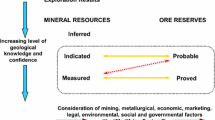Abstract
All historical periods of Kosovo—Ilirik, Roman, Medieval, Turkish, and former Yugoslavian—are linked with the intensive development of mining and metallurgy. This activity influenced and still is influencing the overall position of Kosovo as a country. For example, according to a 2006 World Bank report as well as other studies, Kosovo has potential lignite resources (geological reserves) of about 1.5 billion tonnes, which are ranked fifth in the world in importance. Other significant Kosovan mineral resources include lead, zinc, gold, silver, bauxite, and uranium, and rare metals accompanying those minerals, including indium, cadmium, thallium, gallium, and bismuth. These rare metals are of particular importance in developing advanced industrial technologies. Kosovo also has reserves of high-quality non-metals, including magnesite, quartz grit, bentonite, argil, talc, and asbestos. No database exists for these non-metal reserves, and further research and studies are needed.
Similar content being viewed by others
Bibliography
Beqiri, E., “Quality Valorization of Kosovo Natural Resources” (Presentation at ASHAK, Science Conference, Prishtinë, 1995).
Çerskov, E., “Municipium DD kod Socanice” (Dissertationes et Monographiae, Prishtinë-Beograd, 1970).
Kosovo Energy Corporation, http://www.kek-energy.com .
“Kosovo Mining after the War,” DMM—EU Pillar (Pristine, 2001).
Limari, S., “Valorization of Energetic Resources in the Function of Kosovo’s Development” (Presentation at ASHAK, Science Conference, Prishtinë, 1995).
Mineral Resources of Kosovo (Prishtine, Kosovo: Kosovo Government, MEM, 2005).
“Mining and Geology Policy Paper,” DMM—EU Pillar (Pristine, 2003).
Nelles, P.L., et al., “Trepca Resurgence?” World of Metallurgy, 60(5) (2007).
Peci, N., and S. Mulaj, “Mineral Resources of Kosovo” (Presentation at the Conference on Road Infrastructure, Prishtinë, 2007).
Rizaj, M., and H. Mehmeti, “Status and Development Perspectives of a Nonferrous Metals Industry” (Presentation at the Sohn International Symposium on Advanced Processing of Metals and Materials: Principles, Technologies and Industrial Practice, San Diego, California, 27–31 August 2006).
Rizaj, M., S. Kastrati, and S. Restelica, “Mining, Metallurgy and Chemical Industry in Kosovo” (Presentation at the Conference SHTM&SHXK, Prishtinë, 2008).
Steblez, W.G., “The Mineral Industry of Serbia and Montenegro,” U.S. Geological Survey—Minerals Information (Washington, D.C.: USGS, 1996).
Author information
Authors and Affiliations
Corresponding author
Rights and permissions
About this article
Cite this article
Rizaj, M., Beqiri, E., McBow, I. et al. The mineral base and productive capacities of metals and non-metals of Kosovo. JOM 60, 18–22 (2008). https://doi.org/10.1007/s11837-008-0101-4
Published:
Issue Date:
DOI: https://doi.org/10.1007/s11837-008-0101-4




